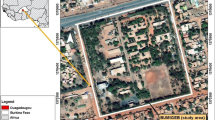Abstract
Metals were studied in topsoils surrounding a cement plant near the Euphrates River, Iraq. Bulk concentrations of SiO2, Al2O3, CaO, MgO, Na2O, K2O, Fe, Ni, Cu, Zn, Cd, Pb, pH, organic matter, clay, sand, and silt were analyzed. The results indicate that the soils in the area are primarily alkaline with an average pH of 8.8; the texture is sandy loam. The CaO percentages were found to be high (31.9 wt% average). Soil levels of Pb, Zn, and Cd levels close to the cement plant are higher than the values reported in the literature. An enrichment factor calculation suggests that Ni, Cu, Zn Cd, and Pb have anthropogenic sources and exhibit a significant level of contamination. Principal component analysis identified Pb, CaO, Zn, and Cd as the signature geochemical characteristics that are associated with the cement factory. Moreover, most of the affected soils exhibit a NW–SE trend, which coincides with the prevailing winds in the study area. This pattern is indicative of dry deposition as the primary mechanism for metal accumulation. The hazard index (HINi-Zn-Cd–Pb) was found to be 0.619 for cumulative metals, representing the highest value reported for health risk related to impacted soils by cement industry.





Similar content being viewed by others
References
Al-Khashman OA, Shawabkeh RA (2006) Metals distribution in soils around the cement factory in southern Jordan. Environ Pollut 140(3):387–394
Al-Omran AM, Maghraby SE (2011) Impact of cement dust in some soil properties around the cement factory in Al-Hasa Oasis, Saudi Arabia. Am Eurasian J Agric Environ Sci 11(6):840–846
Bermudez GMA, Moreno M, Invernizzi R, Plá R, Pignata ML (2010) Heavy metal pollution in topsoils near a cement plant: the role of organic matter and distance to the source to predict total and HCl-extracted heavy metal concentrations. Chemosphere 78(4):375–381
Biasioli M, Barberis R, Ajmone-Marsan F (2006) The influence of a large city on some soil properties and metals content. Sci Total Environ 356(1–3):154–164
Chen TB, Zheng YM, Lei M, Huang ZCh, Wu HT, Chen H, Fan KK, Yu K, Wu X, Tian QZ (2005) Assessment of heavy metal pollution in surface soils of urban parks in Beijing, China. Chemosphere 60:542–551
Gee GW, Bauder JW (1996) Particle size analysis. In: Methods of soil analysis. Part 1, 3rd Edn. In: Sparks DL et al. (eds.) Physical and Mineralogical Methods. Am Soc Agron Soil Sci Soc Am, Madison, pp 377–382
Grantz DA, Garner JHB, Johnson DW (2003) Ecological effects of particulate matter. Environ Int 29:213–239
Ibanga IJ, Umoh NB, Iren OB (2008) Effects of cement dust on soil chemical properties in Calabar environment, southeastern Nigeria. Comm Soil Sci Plant Anal 39:551–558
Manly BFJ (1994) Multivariate statistical methods: a primer, 2nd edn. Chapman and Hall, Boca Raton. http://www.cemnet.com/Publications/global-cement-report-10
Paterson E, Sanka M, Clark L (1996) Urban soils as pollutant sinks: a case study from Aberdeen, Scotland. Appl Geochem 11(1–2):129–131
Peltola P, Aström M (2003) Urban geochemistry: a multimedia and multielement survey of a small town in northern Europe. Environ Geochem Health 25:397–419
Rudnick RL, Gao S (2003) The Composition of the Continental Crust, vol 3. In: Holland HD, Turekian KK (eds) Treatise of geochemistry. Elsevier-Pergamon, Oxford
Saralabai VC, Vivekanadau M (1995) Effect of application cement kiln-exhaust on selected soil physico-chemical and biological properties. Fert Res 40:193–196
Schuhmacher M, Domingo JL, Garreta J (2004) Pollutants emitted by a cement plant: health risks for the population living in the neighborhood. Environ. Res. 95:198–206
Schuhmacher M, Nadal M, Domingo JL (2009) Environmental monitoring of PCDD/Fs and metals in the vicinity of a cement plant after using sewage sludge as a secondary fuel. Chemosphere 74:1502–1508
Sielaff K, Einax JW (2007) The application of multivariate statistical methods for the evaluation of soil profiles. J Soils Sediments 7(1):45–52
Sparks DL, Page AL, Miller RH, Keeney DR (eds) (1996) Methods of soil analysis, Part 3. Chemical methods, 3rd edn. Am. Soc. Agron. and Soil Sci. Soc. Am, Madison
U.S. EPA (2009) Highlights of the Child-Specific Exposure Factors Handbook (Final Report). U.S. Environmental Protection Agency, Washington, DC, EPA/600/R-08/135
U.S. EPA (2013) Regional screening levels (RSL) for Chemical contaminants at superfund sites. U.S. Environmental Protection Agency, Washington, DC
Zerrouqi Z, Sbaa M, Oujidi M, Elkharmouz M, Bengamra S, Zerrouqi A (2008) Assessment of cement´s dust impact on the soil using principal component analysis and GIS. Int J Environ Sci Tech 5(1):125–134
Conflict of interest
We declare that we have no financial and personal relationships with other people or organizations that can inappropriately influence our work. Opinions in the paper do not constitute an endorsement or approval by the funding agencies and only reflect the personal views of the authors.
Author information
Authors and Affiliations
Corresponding author
Rights and permissions
About this article
Cite this article
Khwedim, K., Meza-Figueroa, D., Hussien, L.A. et al. Trace metals in topsoils near the Babylon Cement Factory (Euphrates River) and human health risk assessment. Environ Earth Sci 74, 665–673 (2015). https://doi.org/10.1007/s12665-015-4071-x
Received:
Accepted:
Published:
Issue Date:
DOI: https://doi.org/10.1007/s12665-015-4071-x




